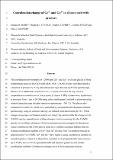Files in this item
Coordination change of Ge4+ and Ga3+ in silicate melt with pressure
Item metadata
| dc.contributor.author | Mare, Eleanor Rose | |
| dc.contributor.author | O'Neill, Hugh | |
| dc.contributor.author | Berry, Andrew | |
| dc.contributor.author | Frigo, Corinne | |
| dc.contributor.author | Glover, Chris | |
| dc.date.accessioned | 2022-03-16T00:41:12Z | |
| dc.date.available | 2022-03-16T00:41:12Z | |
| dc.date.issued | 2021-03-16 | |
| dc.identifier | 273217964 | |
| dc.identifier | ec3fc74b-bc47-41e1-b5aa-20eeda59e029 | |
| dc.identifier | 000651801700010 | |
| dc.identifier | 85104356281 | |
| dc.identifier.citation | Mare , E R , O'Neill , H , Berry , A , Frigo , C & Glover , C 2021 , ' Coordination change of Ge 4+ and Ga 3+ in silicate melt with pressure ' , Geochimica et Cosmochimica Acta , vol. In press . https://doi.org/10.1016/j.gca.2021.03.008 | en |
| dc.identifier.issn | 0016-7037 | |
| dc.identifier.other | ORCID: /0000-0003-0531-7755/work/90952296 | |
| dc.identifier.uri | https://hdl.handle.net/10023/25054 | |
| dc.description | HON thanks the Australian Research Council for funding through grant FL130100066. ERM acknowledges an Australian Government Research Training Program Scholarship (formerly Australian Postgraduate Award). | en |
| dc.description.abstract | The coordination environments of ∼ 2000 ppm Ge4+ and Ga3+ in silicate glasses of three compositions based on the CaO-MgO-Al2O3-SiO2 (CMAS) system were determined as a function of pressure by X-ray absorption near edge structure (XANES) spectroscopy. Glasses of 11 additional compositions were examined to check for any effect of composition on coordination at low pressure (1 atm to 1 GPa). Glasses were synthesised at pressures from 1 atm to 10 GPa using either a melt-quench method or glass-annealing method (annealing near the glass transition temperature, ∼780 °C). The glasses also contained H2O and CO2, which were quantified by attenuated total reflectance infrared spectroscopy, using an estimated density-normalised calibration factor for CO2. While changes in average coordination number are sensitively monitored by the changes in the XANES spectra, quantification of these changes requires assuming that the XANES spectra of crystalline substances of known structure provide analogues for the glasses. Linear combination fits of the spectra using the crystalline analogues indicate that the average coordination numbers of Ge4+ and Ga3+ increase from 4 at ambient pressure to approximately 5 at 10 GPa. Ge4+ and Ga3+ have higher average coordination numbers in annealed glasses compared to those from quenched melts prepared at the same pressure up to 4 GPa, but at 5–6 GPa quenched melts and annealed glasses record similar coordination numbers. Coordination changes occur at lower pressures in more depolymerised melt compositions, and are therefore relevant to natural melts of the mantle. The partition coefficients of Ge and Ga between melts and coexisting minerals are likely to be affected by such coordination changes. | |
| dc.format.extent | 4885178 | |
| dc.language.iso | eng | |
| dc.relation.ispartof | Geochimica et Cosmochimica Acta | en |
| dc.subject | Germanium | en |
| dc.subject | Gallium | en |
| dc.subject | XANES | en |
| dc.subject | Fictive temperature | en |
| dc.subject | Fictive pressure | en |
| dc.subject | GE Environmental Sciences | en |
| dc.subject | DAS | en |
| dc.subject.lcc | GE | en |
| dc.title | Coordination change of Ge4+ and Ga3+ in silicate melt with pressure | en |
| dc.type | Journal article | en |
| dc.contributor.institution | University of St Andrews. School of Earth & Environmental Sciences | en |
| dc.identifier.doi | 10.1016/j.gca.2021.03.008 | |
| dc.description.status | Peer reviewed | en |
| dc.date.embargoedUntil | 2022-03-16 |
This item appears in the following Collection(s)
Items in the St Andrews Research Repository are protected by copyright, with all rights reserved, unless otherwise indicated.

